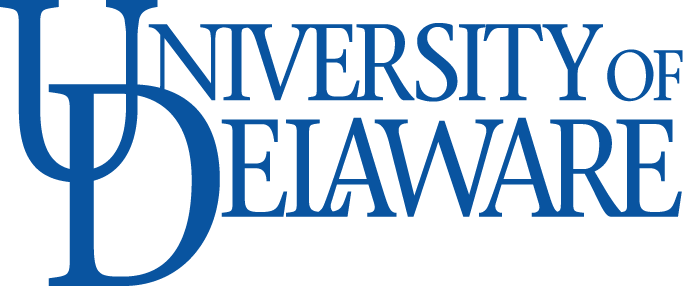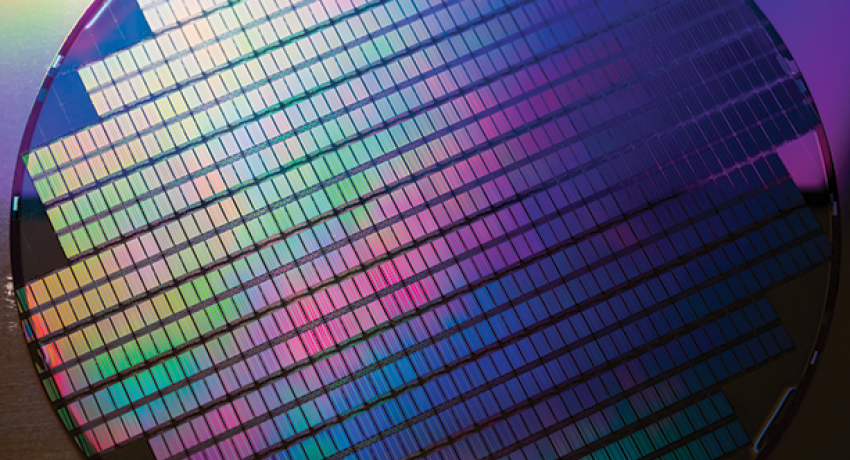Silicon wafer used for fabrication of integrated circuits. Credit: Adobe Stock
By Jamie Oberdick
As outlined in the CHIPS and Science Act, regional hubs would play a key role in an American semiconductor future.
Part of what will help make the CHIPS and Science Act a success is the concept of regional hubs, where partnerships among industry, government, and universities like Penn State will thrive. Penn State brings a lot of semiconductor expertise to the table, but what about potential university partners in the region? What would a joint university partnership look like?
In the Mid-Atlantic region, Penn State has many neighboring universities that also hold a lot of semiconductor expertise. They complement each other and offer unique resources, skills, and strengths. Penn State has forged relationships with these universities over the years, and the CHIPS and Science Act offers a significant opportunity to build on these connections and take the lead in forming a Mid-Atlantic version of a regional semiconductor hub.
What follows is just a small sampling of neighboring universities with whom Penn State is exploring how they can, together, help to chart a new course for America’s semiconductor future. We will highlight other partners, including those in industry, over the next few issues of Focus on Materials as we update the exciting progress in building these regional hubs.

As far as contribution to a regional partnership, Craig Arnold, vice dean for innovation and Susan Dod Brown Professor of Mechanical and Aerospace Engineering at Princeton University, touts Princeton’s diversity of semiconductor-related strengths.
“Princeton University has an incredibly diverse and deep community in the area of semiconductors covering different materials, different processing methods, etc.,” Arnold said. “In addition, we have a 15,000-square foot cleanroom with a corresponding packaging lab and a soft materials processing lab. Within our facility, we have a number of companies that work with us, and we have close ties to the Princeton Plasma Physics Laboratory, a Department of Energy national lab that focuses on Plasma processing in semiconductor manufacturing.“
While Princeton, like Penn State, boasts manifold strengths in semiconductor research, Princeton is anticipating a regional partnership will have many benefits for all partners, and beyond. “Given the scale and diversity of the semiconductor industry, it is critical that universities collaborate,” Barry Rand, associate professor of electrical and computer engineering and the Andlinger Center for Energy and the Environment, said. “Without such collaborations, researchers would not be exposed to the breadth, reach, and scope of the semiconductor ecosystem.”
Similar thinking, Rand said, goes for partnerships with industry, especially for a key aspect of the CHIPS and Science Act, workforce development.
“Additionally, such partnerships bring considerable value to academic research, as industrial researchers understand the critical problems that require urgent solutions,” Rand said. “These problems will thus lead to the greatest impact for society and generate a well-trained workforce. I think an ideal hub would include a combination of industry, government, and academia. Colleges and universities would play the key roles of workforce training and advanced research and development.”

New York University is developing two new research facilities in Brooklyn, New York that are available to any potential partner in a regional semiconductor hub. One is a cutting-edge nanofabrication facility and another is a state-of-the-art THz measurement facility. These will fuel advanced research in quantum and THz electronics in the United States. These new facilities can also serve as training grounds for future semiconductor workers. This would be a perfect complement to the global-leading efforts for workforce development at Penn State, including the extensive work described in this issue of Focus on Materials being done by Osama Awadelkarim as director of the Center for Nanotechnology Education and Utilization.
“These two cutting-edge research facilities at NYU support several Research Centers within NYU in the fields of Quantum and Communications,” Davood Shahrjerdi, associate professor of electrical and computer engineering with NYU and director of the NYU Nanofabrication Facility, said. “A hallmark of these research centers is their strong connections with the semiconductor industry. Lastly, these research centers at NYU have well-established workforce development pipelines for educating the next generation of diverse engineers and researchers in the field of semiconductor manufacturing.”
Shahrjerdi envisions that a regional hub featuring Penn State and other universities would create a synergy of capabilities around semiconductors, while a partnership with industry would help set the agenda. The inter-university partnership is crucial for amplifying the unique strengths of different universities in accomplishing this mission, facilitating a closer collaboration and development of unified strategies toward the lab-to-fab translation of cutting-edge research on unconventional semiconductors,” Shahrjerdi said. “At the same time, the industrial partnership is crucial for understanding the needs of the semiconductor industry.”
The future semiconductor hub in the mid-Atlantic would come at a crucial time, Shahrjerdi believes, not just because of the need to the United States to revitalize its chip industry, but also at a time when new technology is needed to move the field forward.
“The semiconductor industry is at a critical juncture as the conventional silicon transistor scaling is running out of steam,” he said. “The ideal hub will focus on radical scientific and technological innovations that can result in groundbreaking technologies with an emphasis on their translations into manufacturing settings. It will also have a strong workforce development component for training the next generation of engineers and researchers necessary for this next step.”

The University of Maryland brings a diverse set of research groups and facilities for the design, testing, and analysis of semiconductor devices. This includes their Institute for Systems Research, which works in hardware design and security, bioelectronics, RF electronics, and edge computing hardware, among others, and the Center for Advanced Life Cycle Engineering, which provides expertise in reliability analysis, accelerated testing, risk mitigation, and life cycle analysis for advanced electronics systems.
However, like in real estate, a Maryland strength is location, location, location – In this case, their proximity to our nation’s capital, Washington, D.C.
“One of our strengths that we have is our close proximity and strong collaborations with local defense industry and defense labs which allows us to partner on addressing the unique needs found in government electronics,” Samuel Graham, Jr., dean of the A. James Clark School of Engineering at the University of Maryland, said.
Graham said that Maryland is excited to participate in a semiconductor research hub because it would create a “value chain” for the future of chips.
“An ideal hub would include strengths in the critical aspects of design, manufacturing, packaging, and testing to allow for prototyping and creating new microelectronics technologies,” Graham said. “It will also provide a place for workforce development through experiential learning or training on critical pieces of this value chain.” For Pamela Abshire, professor of electrical and computer engineering at the University of Maryland, a challenge to tackle is the scale of semiconductors. Microelectronics is a big field, responsible for nearly a quarter of global GDP.
"It is hard for any one institution to cover all of that ground, so partnerships among universities and with government and industry take on a critical role as our nation begins to reinvest in domestic capability in semiconductors and microelectronics,” Abshire said. “In many other countries, universities work much more closely with industry than in the U.S. We can't build a strong American semiconductor industry without coordination, collaboration, and frequent interactions and feedback from our industrial partners.”
These points, Abshire noted, were among the main takeaways from the Mid-Atlantic Microelectronics and Heterogeneous Integration Workshop, where colleagues from academia, industry, and government gathered in August at the University of Maryland College Park. “The main take-home messages included, first, strong support for regional prototyping capabilities, second, advantages of better coordination among academia, government, and industry, and third, the critical need for developing and sustaining the microelectronics workforce,” Abshire said.

One of the research strengths of the University of Delaware fits in well with the CHIPS and Science Act – photonic integrated circuits.
“We have a history here at Delaware with optoelectronic devices and integrated photonics on silicon and other platforms,” said Jamie Phillips, professor and chair of the Department of Electrical and Computer Engineering at the University of Delaware. “One of our key faculty members, Dennis Prather, is an expert in thin film lithium niobate. We have one of the only sources of thin film lithium niobate domestically in the US, which is an enabling technology for photonics on a chip. He co-founded a company, Phase Sensitive Innovations, that has commercialized that technology.”
Other strengths at Delaware include a user facility for epitaxial growth, emerging research in the field of quantum science and technology, and on the educational side, a new multidisciplinary quantum science and engineering graduate program that would feed into CHIPs Act-related semiconductor activities.
Phillips sees partnerships among universities as key because of important factors such as redundancy of facilities, where a partner can offer their facility to another partner in the case of something such as a clean room issue or equipment failure. They can also work together to incubate startup companies and offer their facilities to these new-born entities.
"It’s very difficult and prohibitively expensive to establish a cleanroom facility on your own but being able to take advantage of an open nanofab that they can use to develop their products is critical for further innovation and new technologies,” Phillips said.
For a potential Mid-Atlantic university partnership for semiconductor research and development, Phillips sees a synergistic relationship where partners with complementary strengths would be able to create new centers where faculty from various semiconductor subcategories would be able to combine expertise and resources to create something bigger.
"I think there are some really powerful selling points in enabling, say a Mid-Atlantic, New York to Washington, DC type of a research hub,” Phillips said. “We would have a geographical advantage given all the universities and other entities around us, particularly in the defense sector."
Partnerships to create a semiconductor regional powerhouse in the mid-Atlantic
As mentioned, this is just a sampling of potential partners in a regional semiconductor research and workforce development hub that Penn State is leveraging prior relationships to build, and there will be more partners highlighted in upcoming issues. Given Penn State is a long-time leader in both materials research and workforce development, the University is well-positioned to show the way to building a regional, Mid-Atlantic hub that leverages our strengths and our partners’ strengths. These hubs will have a transformative impact in the advancement of U.S.
semiconductor manufacturing, potentially creating a powerhouse partnership among the private sector, academia, and government-funded entities.
American scientists developed these chips as part of the Moon landing program in the 1960s, and we led the industry for decades. This network of facilities, semiconductor materials research leaders, and innovative workforce development and training that Penn State is coordinating will enable America to reassert its leadership role in the world’s semiconductor industry.
This article originally appeared in the Fall 2022 issue of Focus on Materials.

